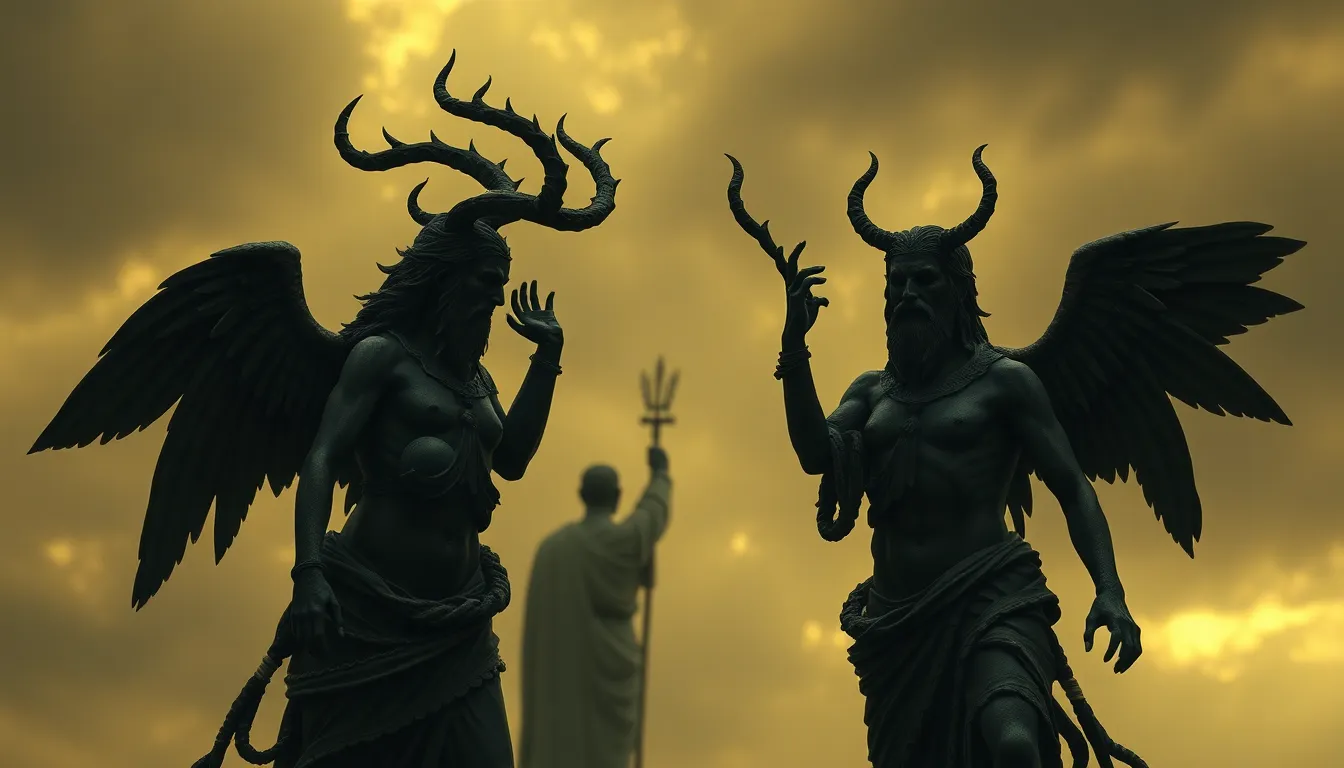The Furies: The Intersection of Mythology and Psychology
I. Introduction
The Furies, known as the Erinyes in Greek mythology, are powerful figures representing vengeance and justice. They are often depicted as fearsome women who pursue wrongdoers relentlessly, embodying the idea that no crime can go unpunished. Their portrayal in ancient narratives highlights their significance as both avengers and enforcers of moral order.
This article aims to explore the psychological implications of the Furies, examining how these mythological figures intersect with human emotions, moral dilemmas, and the quest for justice. By delving into their origins, psychological archetypes, and relevance in modern therapy, we can better understand the complexities of human behavior as reflected in mythology.
II. The Mythological Origins of the Furies
The Furies have deep roots in Greek mythology, originating from the ancient narratives that illustrate their roles as agents of retribution. According to myth, they were born from the blood of Uranus when he was castrated by his son Cronus, signifying their connection to primal justice and the consequences of wrongdoing.
Key stories featuring the Furies include:
- The pursuit of Orestes, who was tormented by the Furies for avenging his father Agamemnon’s murder.
- The trial of Orestes in Athens, where the Furies were transformed into the Eumenides, signifying a shift from vengeance to a more judicial form of justice.
The symbolism of the Furies encompasses themes of vengeance, justice, and the moral order of society. They serve as a reminder that actions have consequences, and their relentless pursuit of wrongdoers underscores the importance of accountability in human relationships.
III. The Furies as Psychological Archetypes
In psychological terms, archetypes are universal symbols or motifs that resonate across cultures and time. The Furies represent a complex archetype that encapsulates repressed emotions and the struggle between justice and revenge.
The Furies exemplify:
- Repressed Emotions: They symbolize the feelings of anger, guilt, and resentment that often go unacknowledged in individuals.
- Justice vs. Revenge: Their duality highlights the fine line between seeking justice and indulging in revenge, a conflict that is prevalent in human relationships.
This complexity allows for a deeper exploration of how individuals cope with feelings of betrayal and the desire for reparation, making the Furies a rich subject for psychological analysis.
IV. The Role of the Furies in Modern Psychology
In contemporary psychological theory, the Furies can be seen as representations of the internal struggles individuals face when dealing with trauma and guilt. They embody the psychological conflict that arises when one seeks justice for perceived wrongs.
Case studies reveal the following connections:
- Trauma: Individuals may experience the Furies within themselves when grappling with past traumas, manifesting as obsessive thoughts or behaviors.
- Guilt: The relentless pursuit of the Furies can symbolize feelings of guilt that haunt individuals until they seek resolution.
- Quest for Justice: The desire to right wrongs can lead to a profound examination of personal ethics and morality.
Understanding the Furies in this context can aid therapists in helping clients navigate their emotions and find healing pathways.
V. The Furies in Art and Literature
Throughout history, the Furies have been depicted in various forms of art and literature, reflecting their significance in culture. In classical art, they are often shown as winged women with serpentine hair, embodying terror and retribution.
Notable literary works that incorporate the Furies include:
- Aeschylus’s “Oresteia”: This trilogy explores themes of vengeance, justice, and the transformation of the Furies into the Eumenides.
- Homer’s “Iliad”: The Furies are mentioned as agents of fate and punishment, emphasizing their role in the moral landscape of the epic.
The cultural impact of the Furies extends beyond Greece, influencing modern storytelling and artistic expressions that address themes of morality, vengeance, and the human condition.
VI. Comparative Analysis: The Furies and Other Mythological Figures
The Furies share similarities with other mythological entities across different cultures, often serving similar functions as avengers or enforcers of moral order. Some notable comparisons include:
- Nemesis: In Greek mythology, she is the goddess of retribution, representing a more direct form of justice.
- Valkyries: In Norse mythology, these warrior maidens choose those who may die and those who may live in battles, embodying fate and retribution.
- Yama: In Hindu mythology, the god of death who judges the souls of the deceased, ensuring moral order.
While the Furies and these figures share themes of vengeance and justice, their representations and functions vary, reflecting the cultural values and beliefs of their respective societies.
VII. Therapeutic Approaches Inspired by the Furies
Mythology plays a significant role in therapy and healing, providing a framework for understanding complex human emotions. Therapists can incorporate the Furies into narrative therapy, allowing clients to explore their feelings of anger, guilt, and the quest for justice.
Examples of therapeutic practices inspired by the Furies include:
- Role-playing: Clients may enact scenarios involving the Furies to confront their feelings of guilt and anger.
- Art therapy: Creating visual representations of the Furies can help clients express repressed emotions.
- Storytelling: Sharing personal narratives that echo the themes of the Furies can facilitate healing and understanding.
These approaches provide valuable tools for individuals seeking to navigate their emotional landscapes and find resolution.
VIII. Conclusion
The intersection of mythology and psychology offers profound insights into the human experience, with the Furies serving as potent symbols of vengeance, justice, and repressed emotions. Their enduring relevance in modern society highlights the complexities of human behavior and the moral dilemmas we face.
As we continue to explore the psychological implications of the Furies, we embrace the richness of human emotions encapsulated in myth. By understanding and integrating these themes into our lives, we can better navigate our own quests for justice and reconciliation.




